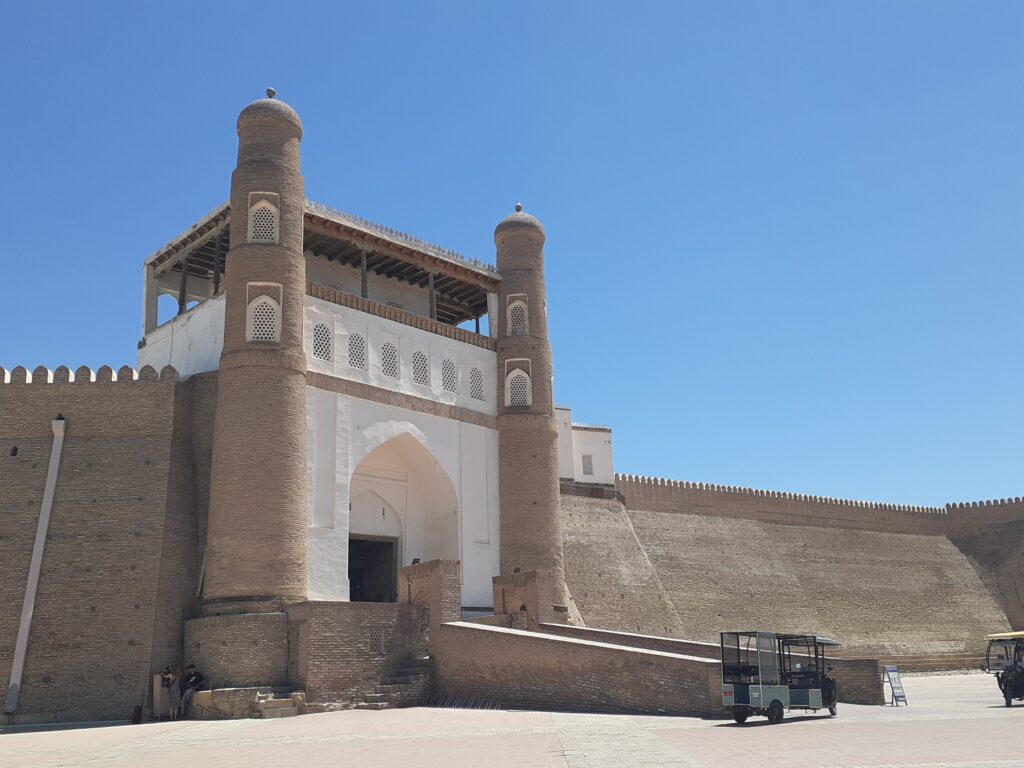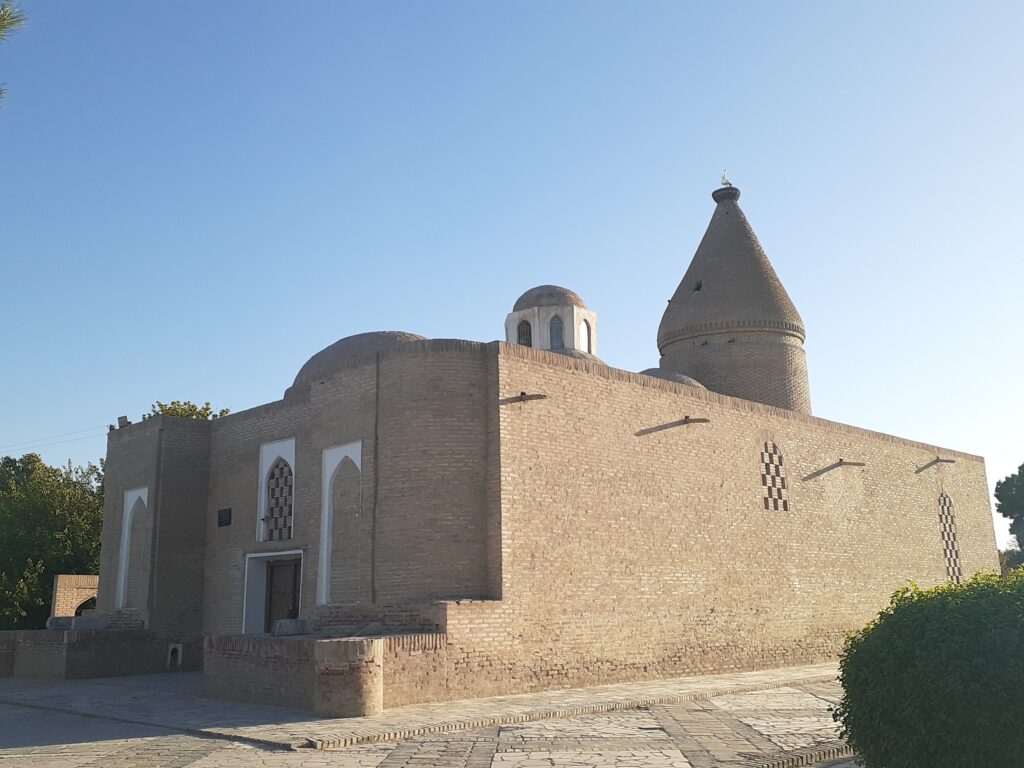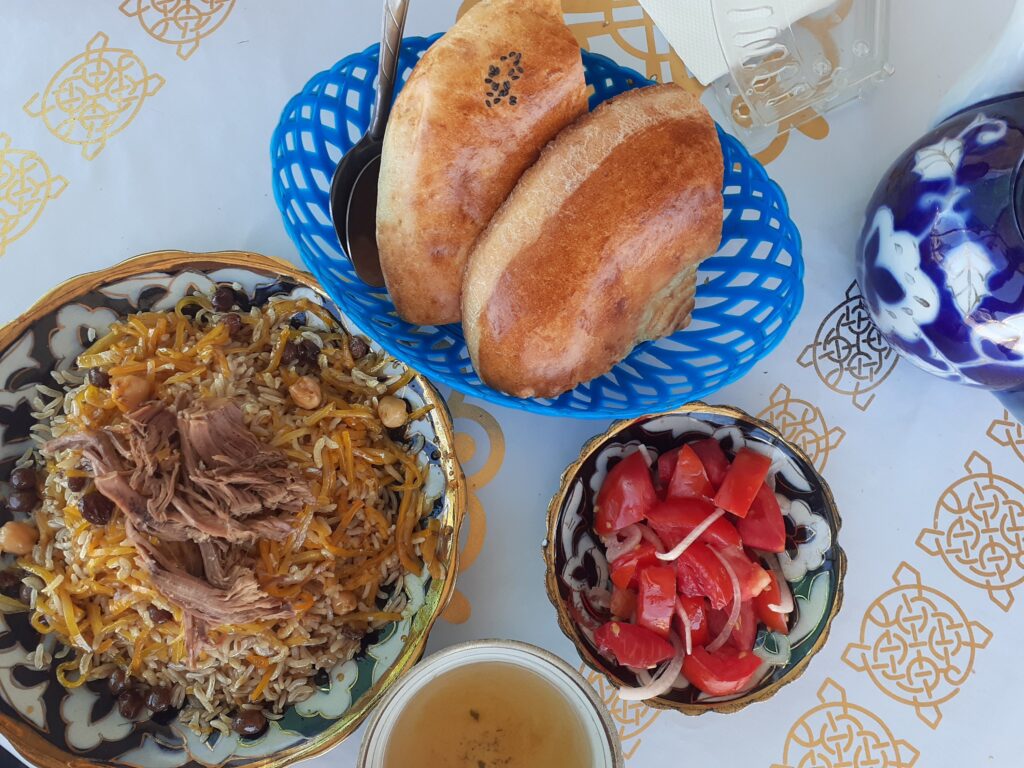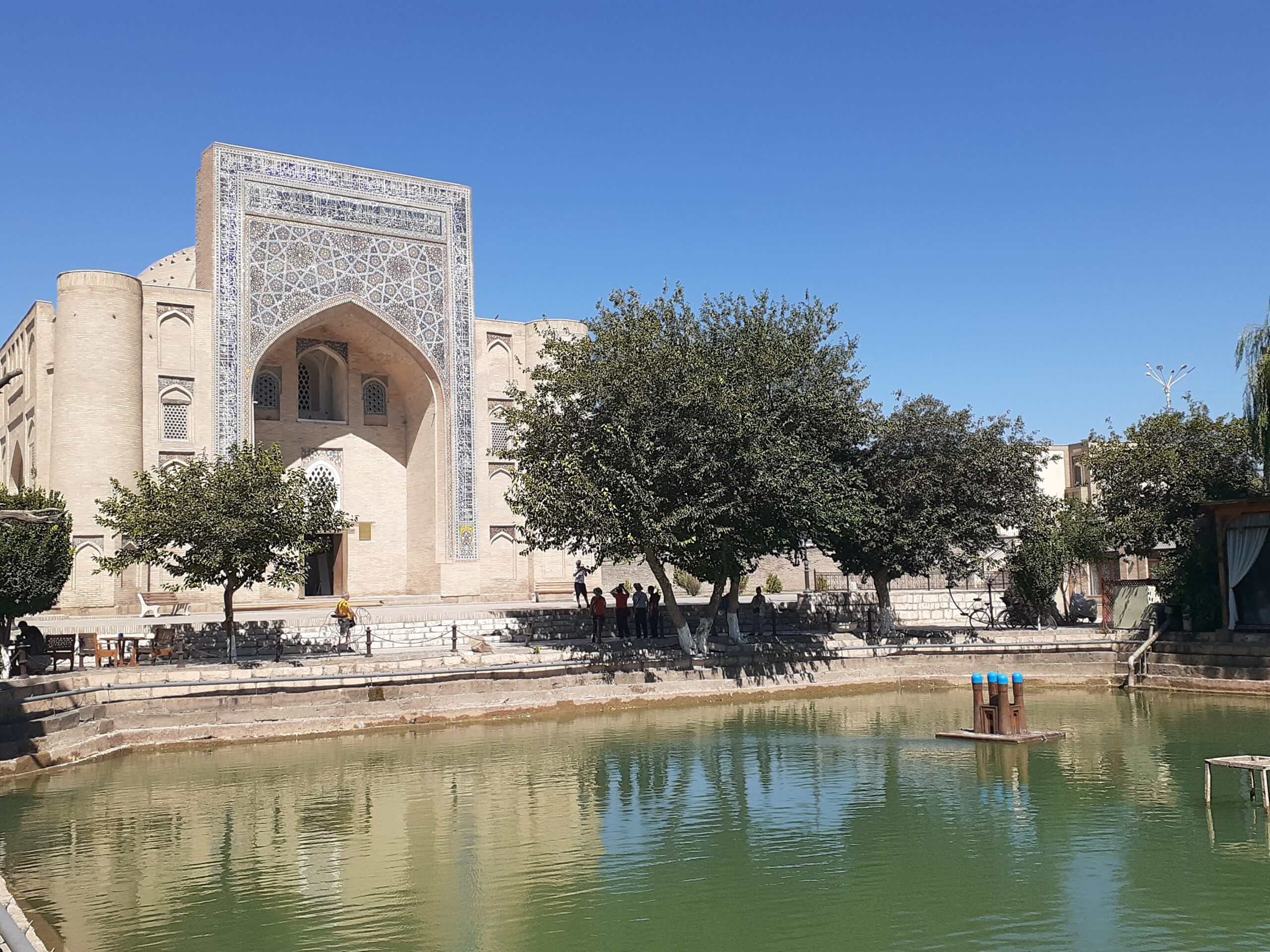Bukhara is a former Silk Road oasis city. It is a large city with a current population of approximately 230,000, but most of the attractions are concentrated in the old town area.
We spent three nights in Bukhara sightseeing. Here are some of the tourist highlights of Bukhara.
- Nodir Devonbegi Madrasah
- Nodir Devonbegi Khonako
- Maghoki Attori Mosque
- Abduraziz Khan Madrasah
- Mir Arab Madrasah
- Kalan Mosque
- Bolo Hauz Mosque
- Ark of Bukhara
- Chor Minor Madrasah
- Ismail Samani Mausoleum
- Turki Jandi Tomb
- Chashmai Ayub Mausoleum
- Palace of the Emir of Bukhara
- Sayfiddin Boharzi Mausoleum
- Sitorai Mokhi-Khosa Palace
- Chor Bakr Memorial Complex
- Green Market
- Accommodation in Bukhara
- Dining in Bukhara
Nodir Devonbegi Madrasah
This madrasah stands in the centre of the old town, to the east of the fountain cistern. It is characterised by a phoenix design at the top of the facade. Apart from that, there are also patterns with sun and human motifs, which is unusual for an Islamic site.
It was initially built in 1623 as a resting place for caravans on the Silk Road, but was later converted into a madrasah.
Once inside, cafés and shops line the patio. It is fun just to walk around and admire the architecture. Although we didn’t see it, there are live folk music and dance shows in the courtyard later in the evening. In the green area in front, there is a statue of a legendary hero.
The facade of the madrasa faces west, but it is best to take photos in the early afternoon due to the shadows cast by the trees in the late afternoon.
Nodir Devonbegi Khonako

On the other side of the reservoir (Lyabi Khauz) and opposite Nodir Devonbegi Madrasah is Nodir Devonbegi Khonako. Khonako is a Sufi temple and once the residence of Sufis.
Restaurants are lined up around the reservoir, where visitors can dine while enjoying the view of the fountain. The reflections of Khonako and swans on the water making to very picturesque.
Maghoki Attori Mosque
Before the Arabs who brought Islam to Bukhara, there was a market near here where Zoroastrian idols, medicinal herbs and spices ‘atron’ were sold, called the Attron Bazaar. The mosque was built after the destruction of the original Zoroastrian temple in 714. It was subsequently destroyed by fire several times and rebuilt each time.
The façade of the mosque has preserved its ancient atmosphere. The round, double-curved columns on either side of the door are remnants of the pre-Islamic period.
In an area where many Islamic buildings have been meticulously reconstructed, this mosque stands out from the rest with more original atmosphere. I enjoyed the unpainted, rustic appearance.
Abduraziz Khan Madrasah
Built in 1653, this madrasah was a lavishly decorated madrasah building planned from the outset. It is said to be the first Central Asian building in which yellow paint was used for decoration. Its motifs are diverse and include flowers, animals, birds, dragons and trees.
Particularly eye-catching is the flamboyant façade. The dome section has two levels of arches, with an even finer arch over the top. The exquisite decoration in each of the hollows and the colours that change subtly in the sunlight make it a wonderful place to visit several times a day. The façade alone is probably the most beautiful of any Islamic building in Bukhara.
Mir Arab Madrasah
This madrasah stands opposite the Kalan Mosque. This blue two-domed madrasah was built in the 16th century.
The facade is covered with blue tiles and decorated with geometric and botanical patterns and calligraphy.
Kalan Mosque
This mosque is located opposite the Mir Arab Madrasah and is flanked by the beautiful Kalon Minaret. It is said to have been first built in the 15th century.
The entrance fee is 5,000 soms per person. Part of the interior was under renovation when we visited, but you should still go. Gates have been built on each of the four sides of the courtyard, which is lined with small rooms, and there is a prayer hall in the direction from where you enter.
Bolo Hauz Mosque
This is the Friday mosque on the opposite side of the road from the Ark fortress. ‘Hauz’ means reservoir, and Bukhara mosques traditionally tended to be built adjacent to reservoirs, as is the case with this mosque.
The open space with 20 columns on the east side was used as a summer prayer hall, and it is known that this brick-enclosed area on three sides was extended in the 20th century.
The summer mosque area, which opens towards the reservoir, has a gorgeous painted ceiling above the relief-embellished wooden pillars, which are reflected in the reservoir. Be sure to go around to the other side of the cistern and sit on the benches. You can admire the beauty of this mosque from a different perspective.
Ark of Bukhara

A fortress is known to have existed here since the 4th century BC. It was the residence of the Bukhara Khan and included state institutions, a mint, various shops, an armoury, a prison and a mosque.
Chor Minor Madrasah

This is an unusual madrasah with four domes and each of the towers has a different design. Featured on the cover of Lonely Planet’s Uzbekistan 2014 edition.
Ismail Samani Mausoleum

Completed in 905, this is the oldest Islamic monument in Bukhara and one of the oldest buildings made of baked bricks in Central Asia. Ismail Samanid, founder of the Samanid dynasty, built this mausoleum for his father, but it is believed that all Samanid clans were later buried here. It remains a sacred place for the local people.
The geometric cubic structure is very attractive. As we approached, we were surprised to see that it was a meshwork, allowing us to see through to the inside. The mausoleum looks massive from afar, but up close it is light and cool. This is a place you should definitely visit.
Turki Jandi Tomb
The mausoleum is said to contain mausoleums built in the 12th, 14th and 16th centuries, but the exact date is unknown; it was restored in 2020.
Located south of the old town centre, it is dedicated to Turki Jandi, who lived in the 10th century. He was a scholar and a leader in the field of science who came to St Bukhara from Jand (an ancient city on the Shirdarya River) to study in the Bukhara madrasa as a young man.
Even today, local people come to pray in his honour.
Chashmai Ayub Mausoleum

This is a sacred site with a legendary healing well. The conical dome is unusual in Bukhara.
Palace of the Emir of Bukhara
Located near Bukhara railway station. We did not go inside, but the building itself is beautiful and worth a visit.
Sayfiddin Boharzi Mausoleum
Located 3 km east of the old town centre. The main building with two spiky domes stands beside a small minaret. Appropriate clothing is required to enter, like all mosques.
Sitorai Mokhi-Khosa Palace
As it is a bit far from the old town, we took a Yandex taxi to get there. The entrance fee is 40,000 som per person and can be paid by credit card.
It was built between 1912 and 1918 on the orders of Mir Said Muhammad Alim Khan, the last emir of Bukhara. Bukhara masters of the time and Russian engineers were involved.
The White Hall, located immediately after the entrance, makes extensive use of mirrors. The walls are decorated with relief decoration, but they never used the same pattern design repeatedly.
The building where the bedrooms were located is now used as a museum. The outdoor areas of the large grounds may have once been manicured as a garden, but some parts now need a bit of love.
Chor Bakr Memorial Complex
Located in a village about 5km west of Bukhara. It was too far to walk there, because if the temperature, so we took a Yandex taxi. Entrance fee is 10,000 som per person. Chor Bakr means ‘four brothers’, but for some reason it seems to be known abroad as the ‘city of the dead’. The return journey to Bukhara was by minibus at 5,000 som for two of us.
Completed in 1563, it was apparently built over the tomb of Abu Bakr, who died in the 10th century. The large site includes a mosque, minaret and khonaka. The freely spreading branches of trees and fruit trees were well reflected in the brick colour. Today it remains a sacred place and many locals visit the site.
Green Market
A small market, but crowded with people early in the morning. Especially when we visited on Sunday, there were many cars outside and it was very lively.
There was a section selling kitchenware as well as a variety of foodstuffs such as vegetables, fruit, condiments, homemade yoghurt and honey, bread, etc. There were also shops outside selling clothes.
There were no travellers other than us and the vendors were all friendly. Figs were sold for 25,000 som a kilo, so we bought 500g. I think the local price may be a bit less than this, but still very affordable and delicious! July is a bit early in the year for figs, but stil delicious.
Accommodation in Bukhara
We stayed at Hotel Mironshox in Bukhara. We booked the first night online and then stayed for consecutive nights. A double air-conditioned room with breakfast was USD 19 per night and from the second night onwards it was USD 215,000 som. We were very happy with the new guesthouse and the air conditioning and wifi worked very well. A detailed review can be found on Google Maps.
Dining in Bukhara

Bukhara’s old town is a busy area for travellers, so there are plenty of restaurants. However, the main drawback is the touristy prices. One of the closest to the old town centre and still reasonably priced, was Chayxana Xo’ja Nasriddin.
We also visited Milly Taolilar, an authentic professional plov shop. This one is completely for locals and is not touristy. Of course, the prices were normal and full of local customers.



Comment